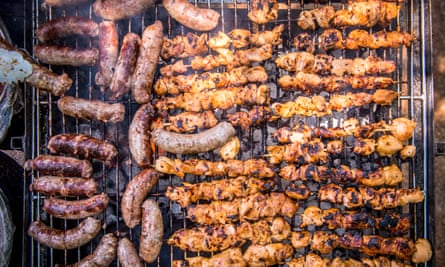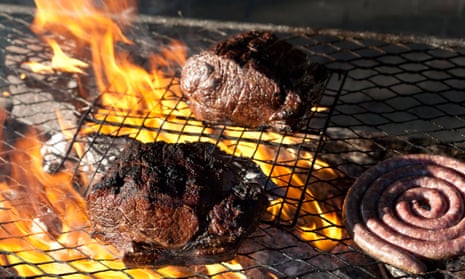Increasingly, traditional British wedding meals – seated, three-course, usually featuring a prawn cocktail – are being scrapped in favour of more unique and informal options. Street food, hog roasts and “bowl foods” were all gaining traction even before the pandemic, which further fuelled the need for alfresco alternatives.
It is little surprise, then, that Carrie and Boris Johnson reportedly opted for a braai – South Africa’s answer to the barbecue – at their belated wedding celebrations last weekend. The event was said to be catered by Corby-based business Smoke & Braai, run by Zimbabwean chef Simon Chiremba, with beef braai boerewors rolls (sausages), masa corn tortilla tacos and smoked barbacoa lamb on the menu. It’s a far cry from the bangers and burgers of a traditional British barbecue – but if you’re thinking of branching out and hosting your own braai, then where is best to start?
One you have the braai itself – which is, in essence, the same as a regular barbecue – it’s important to “be as prepared as you can”, according to Patrick Williams, the South African chef behind Kudu Grill, which centres on a custom-built braai, in south London. He too planned to have a braai at his wedding celebrations in 2020, but was scuppered by lockdowns. “It’s a long process, you tend to only start the fire once the guests arrive. You can’t just bang out burger patties or use gas like you might on a barbecue – it’s not the same flavour. A braai is more of a social occasion: friends, family and neighbours might come over. It’s all about the meat, the fire and the vibe,” Williams says.
While Williams uses wood and charcoal to give his food “nice, smokey flavours”, fellow South African Dan van Straaten, owner of the Coventry-based Let’s Braai, which specialises in selling stainless steel braais, always opts for wood. “We cook over the embers, rather than the flame, which is why we use African hard wood – you can’t do that with British wood,” he says. “It’s extremely dense and heavy, the moisture level is pretty much zero and it smells unbelievably nice.” Let’s Braai sells rooikrans, sekelbos and kameeldoring woods which are “derived from sustainable resources”.

Next, getting the temperature right is key. “Red meats need a high temperature, whereas for fish and chicken you want to thin your charcoal out for a nice slow heat,” says Williams. “So that, when the fat drips, it goes: ‘Hiss!’” Swap pork bangers for more traditional boerewors, which are made from coarsely minced beef (sometimes combined with pork, lamb, or both) and spices, and are available from a number of specialist suppliers in the UK. “The quality of the products makes a big difference and using aged meats can be delicious,” says Williams. “Season well with lots of black pepper and coriander.”
A braai is also a good way to give flavour to vegetables. Sweetcorn is a popular go-to, but Williams likes to braai hispi cabbage. “I cut it in half, and cook it on the low embers until it is nice and caramelised, then turn it over and put the meat on the top, so that all the juices seep into it,” he says.
It was not mentioned on the Johnson menu, but Williams and Van Straaten rave about braaibroodjies, likening them to grilled toasties: cheese, chutney, tomato and onion is the most common filling. “You snack on them with a beer in your hand while you’re waiting for the meat to cook,” says Williams. “They’re also a great brunch option.”
Van Straaten also advocates using a braai to cook potjiekos – a traditional South African stew – in a cast iron pot. “Something like oxtail potjiekos can be left cooking all day. Not everywhere in South Africa has access to gas for cooking, so a braai is a solution for preparing food,” he says. “You can basically cook anything on a braai.”

Comments (…)
Sign in or create your Guardian account to join the discussion